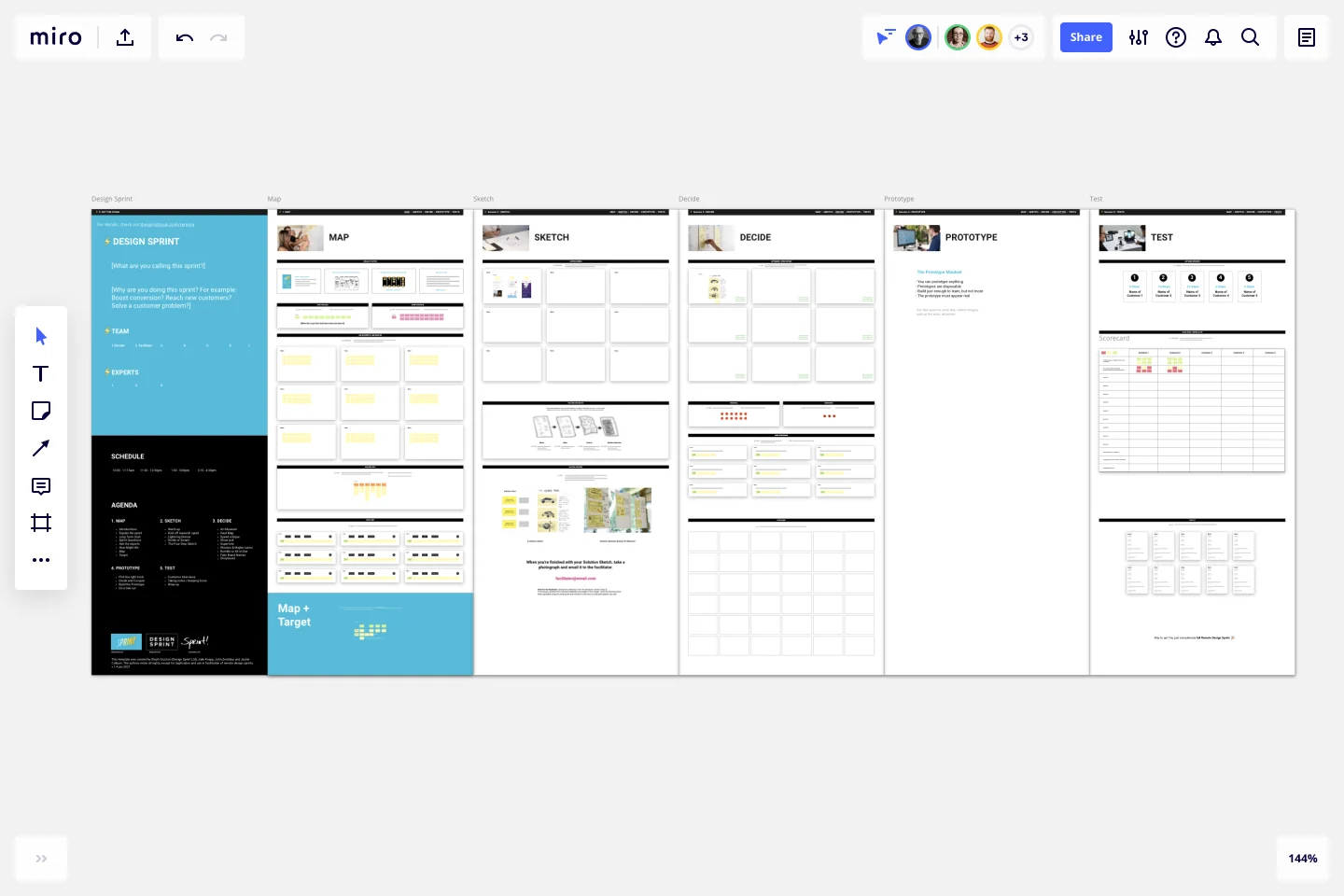Official 5-Day Design Sprint
Use our five-day sprint process to help your team solve problems and test out new ideas.
About the official Remote 5-day Design Sprint template
What Is a Design Sprint?
The big idea with the Design Sprint is to build and test a prototype in just five days. You'll take a small team, clear the schedule for a week, and rapidly progress from problem to tested solution using a proven step-by-step checklist. It's like fast-forwarding into the future.
Why use this Design Sprint template
The experts who literally wrote the book on design sprints created this template, just for Miro. First, facilitator Steph Cruchon of Design Sprint Ltd gathered the agency’s combined experience of physical design sprints and looked for ways to make it efficient and enjoyable in a remote setting. At the same time, the creators of the methodology at Google, Jake Knapp and John Zeratsky, teamed up with Jackie Colburn to write an in-depth guide to run full five-day remote design sprints.
Together, they created this official template for remote sprints, invested personally in writing crystal clear instructions, and even added new exercises that don’t appear in the Sprint book but were part of their workshops. This template works hand in hand with the book and will help you run excellent 100% remote design sprints.
How to use the Design Sprint template
Using the Design Sprint template is easy. Typically how it works is, the facilitator will prep the event before guiding participants through the one big goal for each day of the sprint – to map, sketch, decide, prototype, or test.
For those new to participating in Design Sprints, one of the biggest challenges will be to trust the process. Remember that times it will be overwhelming but that’s part of the process and it’ll all work out.
Miro is the perfect tool to use for your design sprint — remotely or in person. Here’s one way to use it when you're preparing for your next sprint:
Get started by selecting this Design Sprint template.
Read the for advice on tools, preparation, facilitation, and modified tactics.
Give the sprint a name. E.g. “User signup flow.”
Clarify the goal of the sprint. E.g. “To improve the user’s experience as they sign up.”
Ensure you get the right people in the room and assign the roles within the team. Make sure to clarify and brief the role of the facilitator and decider in advance.
Then take the template to the session, because you’re ready to get started!
Invite your team to start collaborating, and don’t forget to share the finished product with the wider company. Be sure to tell everyone about the process and help them understand what you’ve explored and learned about the topic.
How long should design sprints be?
Five days. The design sprint is a **five-day** process for answering critical business questions through design, rapid design prototyping, and testing ideas.
What are the 5 phases of sprint?
Technique training for sprinting can be divided into five areas: starting, acceleration, drive phase, recovery phase, and deceleration
Get started with this template right now.
Experience Mapping Template
Works best for:
Desk Research, Mapping
Plan your product according to your customer’s needs and desires with the Experience Map Template. Bring a customer-centric approach to product development and branding.
Product tone of voice
Works best for:
Product Management, Planning
The Tone of Voice Workshop template helps product teams define and align on brand tone and messaging. By facilitating collaborative workshops, exploring brand personality traits, and defining tone guidelines, this template ensures consistent and impactful communication. With sections for identifying target audience personas, articulating brand values, and crafting messaging principles, it enables teams to create authentic and compelling brand voices. This template serves as a foundation for building strong brand identities and resonating with customers across all touchpoints.
Newsletter Template
Works best for:
Design, Marketing, Desk Research
Using a newsletter template allows you to create a structured and eye-catching newsletter for your subscribers. Add images, text, a call-to-action, and anything else that’ll keep your audience engaged. Take a look at Miro’s newsletter template to start creating unique and distinctive emails today.
Product Hypothesis Canvas
Works best for:
Product Management, Planning
The Product Hypothesis Canvas template assists product teams in formulating and testing hypotheses effectively. By defining assumptions, success metrics, and validation experiments, this template guides teams through the hypothesis validation process. With sections for articulating problem statements, proposed solutions, and expected outcomes, it ensures that hypotheses are clear, testable, and aligned with strategic objectives. This template serves as a framework for hypothesis-driven product development, enabling teams to validate ideas and make data-informed decisions.
Service Blueprint to connect journey & operations
Works best for:
Research & Design
Connect customer journeys with operational processes using the Service Blueprint by Essence. This template helps you map out service interactions and backend processes, ensuring seamless service delivery. Use it to align teams, identify gaps, and enhance the customer experience. Perfect for visualizing the entire service ecosystem and improving coordination between different service components.
Product Brief Brainstorm Template
Works best for:
Product , Product Management
The Intelligent Product Brief Brainstorm template in Miro is crafted to supercharge your product development process. One standout benefit of this template is its AI-powered capabilities that elevate your brainstorming sessions. Not only does it help in organizing and capturing ideas, but it also provides additional insights and solutions, ensuring a thorough and innovative approach to problem-solving. This intelligent feature significantly cuts down the time spent on synthesizing information, allowing teams to concentrate on refining and implementing the best ideas, ultimately leading to more effective and efficient product development.
